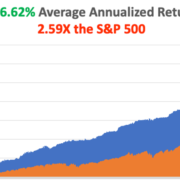After crawling off the mat at the 12% level, and rising all the way back up to 19%, traders are wondering if the Volatility Index (VIX) is finally coming back to life. Or is this just another dead cat bounce?
It wasn?t supposed to work that way. Falling markets should send investors scrambling to buy downside protection in the form of put options, which would automatically send the (VIX). Except when they don?t.
I spoke to over 30 market participants yesterday attempting to root out the cause of this seeming anomaly. All I got was shrugs or idle speculation. A (VXX) at this level, the ETF for the (VIX) assumes that the complacency now endemic in the market will continue for several more months. It is betting that the S&P 500 will continue moving sideways or up with no pullbacks greater that 2%. Oh, really?
It is also discounting a rise in the (SPX) to 1,750, based on a multiple expansion from 16 to 17, while corporate earnings are falling. This will see confirmation when Q3, 2013 earnings start to hit in October. Oh, really, again? It will do this in the face of economies that are dramatically slowing in both Europe and China. Oh, really, a third time?
I finally got through to some friends in the Chicago pits who explained what was going on. A sizeable portion of the trading community believes that we will see a rise in volatility someday, but not in the near future. So they have been buying September call options in the (VIX). To pay for these and hedge out their risk, they have been selling short calls in the front months of December and March at much higher implied volatilities.
Since the (VXX) focuses on only the front two months of the options calendar, it has taken an inordinate brunt of the selling. This is why the (VXX) has continued a rapid decent even on days when the (VIX) was stable and the Dow was down. Needless to say, it has been a huge money maker for the early participants.
How does this end? At some point we do get a serious sell off in the stock market, and the (VIX) rockets back up to 20%, or higher. That means that anyone who initiates this position now will get slaughtered. But the long term players will simply write those losses off against the substantial short dated premium they have taken in in the meantime.
As long as this dynamic is in place, there really is no limit to how far the (VXX) can fall. As traders roll from one expiring month to the next, they will continue to hammer volatility.









